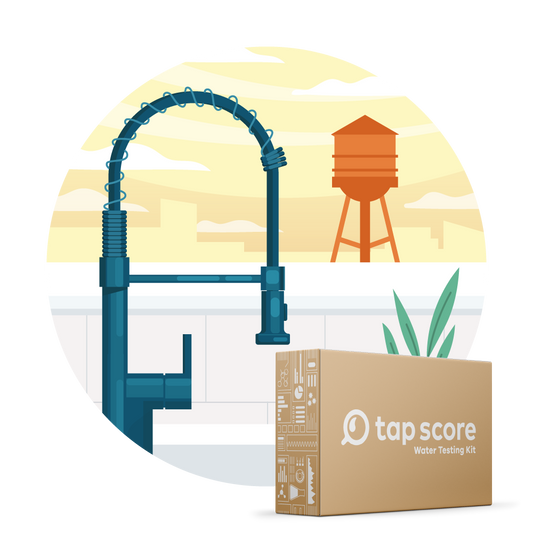
The Dangers of Dioxane in Drinking Water
Our blog is written by real experts— not AI. Each guide is carefully reviewed and updated based on the latest research. Plus, with no affiliate links, you can count on unbiased insights you can trust.
The Industrial Chemical Contaminating Your Tap Water
Water supplies for more than 7 million Americans in 27 states are contaminated with 1,4-dioxane. This industrial chemical has been detected at levels higher than what federal scientists say poses a minimal lifetime risk of cancer, according to an EWG analysis.[1]
But, what does that mean?
Simply put, the minimal lifetime cancer risk is the level of 1,4-dioxane expected to cause no more than one case of cancer for every million people who drink the water daily for their lifetime.
What is 1,4-Dioxane and How Does it Get Into Drinking Water?
Classified as an ether, 1,4-dioxane is a colorless liquid with a faint, sweet odor.[2] It is unstable at elevated temperatures and pressure, and may form explosive mixtures if exposed to light or air for prolonged periods.
Most 1,4-dioxane contamination of drinking water comes from leaking underground storage tanks at hazardous waste sites, or discharges from manufacturing plants.[1] It can also be found in many common personal care products, laundry detergents, and dish soaps. However, tracing contamination to the source is difficult because manufacturers do not have to report discharges of the chemical. What’s more is that when a source is identified, there is little regulators can do to stop contamination–as there are very few enforceable standards.
Once it makes its way into sources of drinking water, 1,4-dioxane tends to stay there–as it does not break down easily. It is completely miscible in water, highly mobile (which means it travels), and very resistant to microbial degradation.[3]
1,4 Dioxane Water Test
Test your drinking water for 1,4 dioxane, an industrial chemical found near military and industrial facilities.
Exposure to 1,4-Dioxane: What Does It Mean for Your Health?
There are various routes of exposure–each of which may also lead to a wide array of human health effects. Means of exposure include:
- Inhalation of vapors
- Ingestion of contaminated food and water
- Dermal (i.e. skin) contact
Symptoms of 1,4-dioxane exposure include:[4]
Short term impacts
- Nausea
- Drowsiness
- Headache
- Irritation of eyes, nose, and throat
Long term impacts
- Dermatitis
- Eczema
- Drying and cracking of skin
- Liver and kidney damage
- Cancer
EPA has classified 1,4-dioxane as “likely to be carcinogenic to humans” by all routes of exposure.[4] The minimal cancer risk level of 0.35 parts per billion (PPB). This equates to approximately one drop in three Olympic-size swimming pools.
Regulation of 1,4-Dioxane
There is no federal maximum contaminant level (MCL) set for 1,4-dioxane in drinking water. However, it has been included in the Contaminant Candidate List (CCL)–an ever-growing list of drinking water contaminants that are known or anticipated to occur in public water systems, which are not (yet) currently subject to EPA regulations.
While lacking enforceable regulation,1,4-dioxane is one of the first 10 chemicals the Environmental Protection Agency picked for review under the Toxic Substances Control Act.[5] Unfortunately, review and regulation are a never-ending game of catch-up–meaning that the processes could take years with no guarantee of any action. To put the rate and speed at which regulation happens, the EPA has not set standards for any new drinking water contaminant in more than 17 years.[6]
What Can You Do About 1,4-Dioxane in Your Tap Water?
Unfortunately, many conventional water treatment options and most in-home water filters do not remove 1,4-dioxane effectively due to its low vapor pressure and high solubility. Of available treatment options, however, UV advanced oxidation processes has been shown to be most effective.
While removing 1,4-dioxane in your water is challenging, it is important to think about longer-term solutions. These include:
- Push for state and federal oversight in order to stop the chemical for getting into the water supply.
- Urge your local utilities company to install the appropriate technology.
- Use databases like EWG’s Skin Deep and Guide to Healthy Cleaning to find products that don’t contain 1,4-dioxane.[7],[8]
-
Read labels and avoid using products with chemicals ending in ‘-eth’ and ’-oxynol’ because 1,4-dioxane can result as an impurity via the manufacturing process.
Read More
▾Personal Care Products: Everyday Pollutants on Your Body – SimpleLab Tap Score
The Exposome: How Environmental Exposures Impact Your Health – SimpleLab Tap Score
Contaminant Candidate List: Unregulated Tap Water Risks | SimpleLab Tap Score
Sources and References
▾- Cancer-Causing Chemical 1,4-Dioxane Contaminates Americans' Drinking Water | Environmental Working Group
- Ether Definition in Chemistry
- 1,4-dioxane - an overview | ScienceDirect Topics
- Technical Fact Sheet – 1,4-Dioxane
- Risk Management for 1,4-Dioxane | US EPA
- US Bolsters Chemical Restrictions for Water
- EWG Skin Deep® Cosmetics Database
- EWG's Guide to Healthy Cleaning | Cleaner Ratings | All Purpose






